benjamin franklin
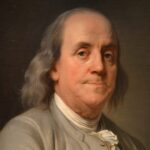
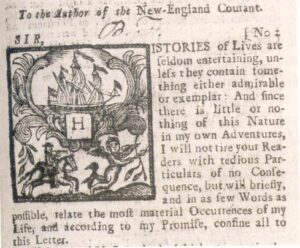 Out of the blue, in 1722, the readers of a paper published in Boston, called The Courant, were treated to and fascinated by letters that were sent in by a widow with an razor-sharp wit and a gift for sarcasm. Her name was Mrs Silence Dogood. Mrs Dogood had an unusual sense of humor. She liked to poke fun at such illustrious institutions such as Harvard. For that, many of her readers loved her and became avid followers. She wasn’t afraid to speak her mind, and she wasn’t afraid to call a spade a spade. She told it like it was, and she didn’t care what others thought of her.
Out of the blue, in 1722, the readers of a paper published in Boston, called The Courant, were treated to and fascinated by letters that were sent in by a widow with an razor-sharp wit and a gift for sarcasm. Her name was Mrs Silence Dogood. Mrs Dogood had an unusual sense of humor. She liked to poke fun at such illustrious institutions such as Harvard. For that, many of her readers loved her and became avid followers. She wasn’t afraid to speak her mind, and she wasn’t afraid to call a spade a spade. She told it like it was, and she didn’t care what others thought of her.
So…just who was Mrs Dogood? Rumor had it that she was just an old widow woman who had been around long enough to have long lost any concern over what people thought of her. Maybe her many years of life had given her insight that no one else had. I remember reading Ann Lander’s column when I was a girl and a young married woman. Her advise always seemed so wise. I remember a number of articles from various columnists, and there again, my thought was, “How did they know so much?” I was sure they must have multiple degrees. Of course, while they might have had a degree or two, that did not make them any smarter than the next guy…and this type of writing was usually more about logic and common sense, that learned skill. So, who was Mrs Silence Dogood? That is the question of the day.
The answer to that question will most likely shock you. The reality is that Mrs Silence Dogood was the pen name used by Benjamin Franklin. Now, while Benjamin Franklin was a very intelligent man, as we all know. the fact remains that at the time he was writing under the pen name of Mrs Silence Dogood, Franklin was a boy of just 16 years. He was too young to be taken seriously or to have any possibility of getting his writings published, so he came up with an ingenious solution. His goal was to have his work published in the New-England Courant…a newspaper founded and published by his brother James Franklin. He took this goal seriously, especially after he was denied several times when he tried to publish letters under his own name in the Courant. Mrs Silence Dogood wrote 14 letters, which were first printed in 1722, and can be read here.
At the time of the printing of those letters, Franklin worked as an apprentice in his older brother’s printing shop in Boston. Franklin was a boy who had yet to get something he wrote published, so at 16, and desperate to finally receive the respect and recognition he felt he justly deserved. His idea was to create the persona of a 
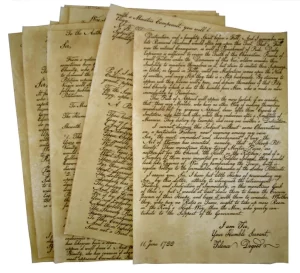 middle-aged widow named Silence Dogood. Once every two weeks, Franklin left a letter under the door of his brother’s printing shop. A total of 14 letters were sent. For months no one knew the identity of Mrs Dogood, but everyone was completely enthralled. Those letters were the talk of the town…even after they found out they were written by a 16-year-old Benjamin Franklin.
middle-aged widow named Silence Dogood. Once every two weeks, Franklin left a letter under the door of his brother’s printing shop. A total of 14 letters were sent. For months no one knew the identity of Mrs Dogood, but everyone was completely enthralled. Those letters were the talk of the town…even after they found out they were written by a 16-year-old Benjamin Franklin.
 Any time you are working with or storing gun powder or other explosives, you run the risk of an explosion. I don’t think that any such explosion is death-free, unless possibly if the factory or warehouse is empty at the time. That is unlikely, because most of these places have at the very least, security personnel working there 24/7 and many run shifts around the clock as well. Of course, that is in today’s world. Back in 1769, however, it is unlikely that people were in the facility 24/7.
Any time you are working with or storing gun powder or other explosives, you run the risk of an explosion. I don’t think that any such explosion is death-free, unless possibly if the factory or warehouse is empty at the time. That is unlikely, because most of these places have at the very least, security personnel working there 24/7 and many run shifts around the clock as well. Of course, that is in today’s world. Back in 1769, however, it is unlikely that people were in the facility 24/7.
A part of the Republic of Venice…Brescia was the site of the Bastion of San Nazaro, a military arsenal and powder storage area. About 200,000 pounds of black powder was stored at the site, enough to destroy about a sixth of the city when a lightning bolt set off the blast in 1769. Because buildings then were not built in such a way as to protect from fire and lightning, there was more risk of disaster than we have today, and there is plenty of 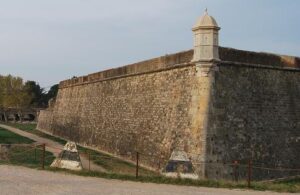 risk today, but possibly less from lightning. Unfortunately, in 1769, disaster came in the form of lightning striking the structure. The ensuing explosion actually devastated the town. When the lightning struck, it started a fire that ignited 198,416 pounds of gunpowder stored at the bastion. As the fire burned, it caused a massive explosion which destroyed one-sixth of the Brescia and killed approximately 6,000 people. Giant rocks and building stones were launched about a kilometer away in every direction, causing massive damage to the surrounding area and crushing unfortunate people. The blast also blew out windows and blew in doors to buildings over a wide area.
risk today, but possibly less from lightning. Unfortunately, in 1769, disaster came in the form of lightning striking the structure. The ensuing explosion actually devastated the town. When the lightning struck, it started a fire that ignited 198,416 pounds of gunpowder stored at the bastion. As the fire burned, it caused a massive explosion which destroyed one-sixth of the Brescia and killed approximately 6,000 people. Giant rocks and building stones were launched about a kilometer away in every direction, causing massive damage to the surrounding area and crushing unfortunate people. The blast also blew out windows and blew in doors to buildings over a wide area.
With a reported death toll of around 6000, this Italian disaster ranks among the worst of the black powder explosions of all time. Who would have thought that an explosion could take out one-sixth of a city? Today,  Brescia has over 200,000 people, and while we don’t know the population back then, we know that a devastation of one-sixth of it killed 3,00 to 6,000 people, so it must have had as many as 50,000 people living there in 1769. The number of fatalities varies among those making estimates, with some saying 3,000. Nevertheless, 3,000 or 6,000 is irrelevant because any loss of life is devastating. This particular tragedy motivated Benjamin Franklin to experiment with the use of lightning rods to protect powder storage buildings. His work found a way to help make buildings a little safer and so lightning rod usage was advised in powder storage buildings…advice apparently taken by the British.
Brescia has over 200,000 people, and while we don’t know the population back then, we know that a devastation of one-sixth of it killed 3,00 to 6,000 people, so it must have had as many as 50,000 people living there in 1769. The number of fatalities varies among those making estimates, with some saying 3,000. Nevertheless, 3,000 or 6,000 is irrelevant because any loss of life is devastating. This particular tragedy motivated Benjamin Franklin to experiment with the use of lightning rods to protect powder storage buildings. His work found a way to help make buildings a little safer and so lightning rod usage was advised in powder storage buildings…advice apparently taken by the British.

 When a country is fighting for recognition, one of the most important events is when other countries recognize your country as being an independent nation. It’s rather hard to conduct business with other nations, if you are viewed as a rouge or non-existent nation. That was the position the United States found themselves in right after the Declaration of Independence was adopted. Just because a country adopts its declaration of independence, doesn’t mean that it’s a done deal. That document can and has been the cause of major wars. The United States was no exception on the war end of that either. They fought long and hard to win that declared independence from Great Britain.
When a country is fighting for recognition, one of the most important events is when other countries recognize your country as being an independent nation. It’s rather hard to conduct business with other nations, if you are viewed as a rouge or non-existent nation. That was the position the United States found themselves in right after the Declaration of Independence was adopted. Just because a country adopts its declaration of independence, doesn’t mean that it’s a done deal. That document can and has been the cause of major wars. The United States was no exception on the war end of that either. They fought long and hard to win that declared independence from Great Britain.
Finally, the coveted recognition came when on December 17, 1777, the French foreign minister, Charles Gravier, count of Vergennes, officially acknowledged the United States as an independent nation. It came after news of the Continental Army’s overwhelming victory against the British General John Burgoyne at Saratoga. The victory gave Benjamin Franklin new leverage in his efforts to rally French support for the American rebels. Although the victory occurred in October, news did not reach France until December 4th. Remember that this mail system was worse than “snail mail” ever was. Messages had to be sent by ship across the ocean.
Benjamin Franklin had quickly mustered French support upon his arrival in December 1776. France’s humiliating loss of North America to the British in the Seven Years’ War made the French eager to see an American victory. Still, the French king worried about the consequences of backing “the rebels” openly. You can’t really blame him because an act like that could bring war to his own country. Still, he did back them in every other way. In May 1776, Louis XVI sent unofficial aid to the Continental forces and the playwright Pierre-Augustin Caron de Beaumarchais helped Franklin organize private assistance for the American cause.
Benjamin Franklin, who often wore a fur cap, captured the imagination of Parisians as an American man of nature and his well-known social charms stirred French passions for all things American. His personality made him the toast of Parisian society. He was very knowledgeable, and he had a way of enchanting groups of people 
 with his wide-ranging knowledge, social graces, and witty conversation. Nevertheless, he was not allowed to appear at court, so any legal assistance he might have offered in the defense of the United States, was never heard.
with his wide-ranging knowledge, social graces, and witty conversation. Nevertheless, he was not allowed to appear at court, so any legal assistance he might have offered in the defense of the United States, was never heard.
Finally, with the impressive and long-awaited rebel victory at Saratoga, Louis XVI was convinced that the American rebels had some hope of defeating the British empire. His enthusiasm for the victory paired with French Foreign Minister Gravier’s concern that the loss of Philadelphia to the British would lead Congress to surrender, gave Franklin two influential allies with two powerful, albeit opposing reasons for officially backing the American cause, and so it was that a formal treaty of alliance with the United States followed on February 6, 1778.
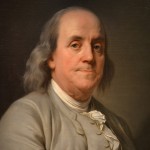
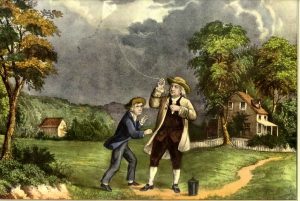 Firefighter and Benjamin Franklin…not usually thought of in the same sentence, but really, they should be. In 1736, Benjamin Franklin was already a young man of influence, but his ambitions didn’t stop at just a few. Most of us think of Benjamin Franklin as a scientist, inventor, founding father, prankster, and writer, but firefighter…hmmmmm, not so much. Nevertheless, Benjamin Franklin was a visionary. He saw a problem and decided to fix it.
Firefighter and Benjamin Franklin…not usually thought of in the same sentence, but really, they should be. In 1736, Benjamin Franklin was already a young man of influence, but his ambitions didn’t stop at just a few. Most of us think of Benjamin Franklin as a scientist, inventor, founding father, prankster, and writer, but firefighter…hmmmmm, not so much. Nevertheless, Benjamin Franklin was a visionary. He saw a problem and decided to fix it.
By 1736 Franklin had adopted Philadelphia, Pennsylvania as his home, but during a visit to his hometown of Boston, Massachusetts, he witnessed a fire, and his mind went into overdrive. What he saw was that the safety precautions to keep fire from spreading seemed to be far more advanced in Boston than in Philadelphia. At that time, Philadelphia’s infrastructure was basically a maze of wooden buildings and houses squeezed together in such a way that it was almost like kindling for a bonfire. Franklin saw this decided that something needed to be done. So, he published his findings in his own Philadelphia Gazette. In doing so, he turned up a different kind of heat. Before long, he was able to round up about 30 of his friends and fellow business owners who were interested. So together, the founded the Union Fire Company. Franklin made sure that The Union Fire Company was a non-profit organization…run completely by volunteers. What made this attractive to these business owners is that it was essentially a promise, to always have each other’s backs, if a fire broke out on or close to one of their properties. Not only were they promising to help extinguish the flames and save homes, but each member was required to keep a heavy-duty bag in which to smuggle out any possessions they could salvage as well. It was a code of honor to try, in the midst of disaster, to salvage whatever they could of the lives of the occupants. The Union Fire Company quickly became the biggest fire relief company in the Colonies, or as they later became, the United States.
Never being one to just sit back and tell others what to do, Benjamin Franklin became a volunteer firefighter himself. Soon, there were six volunteer corps established in Philadelphia. This fire company was the first volunteer fire company of its kind in the United States. When people saw how well the system worked, volunteer fire companies sprung up across the city and soon all over the country. We think of Benjamin Franklin 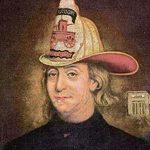
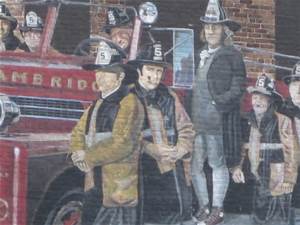 as many things, but in reality, we should maybe think of him as much more than we do. He was the brainchild behind the Great Compromise, which created the Congress we still have today. He was also the first fireman in another way. He “put out the fiery debates” and created a sense of compromise and peace among the founding fathers of our nation too, but he was an actual firefighter in that he actually fought the fires in his city.
as many things, but in reality, we should maybe think of him as much more than we do. He was the brainchild behind the Great Compromise, which created the Congress we still have today. He was also the first fireman in another way. He “put out the fiery debates” and created a sense of compromise and peace among the founding fathers of our nation too, but he was an actual firefighter in that he actually fought the fires in his city.

 Most people think of Benjamin Franklin as the man who discovered electricity, and they would be right, but there was really so much more to the man that just that. While we think of Ben Franklin as a genius, and he was, he only had two years of actual schooling. After that, he quit school to help his family make soap and candles, and later, joined his brother, James as an indentured apprentice at a printing shop when he was twelve. This led to an obsession for books. Franklin loved the written word, and spent much of the little money he made to buy books. Because of his love of books, he became known as an author, printer, politician, postmaster, scientist, inventor, activist, statesman, and diplomat…all of it self taught.
Most people think of Benjamin Franklin as the man who discovered electricity, and they would be right, but there was really so much more to the man that just that. While we think of Ben Franklin as a genius, and he was, he only had two years of actual schooling. After that, he quit school to help his family make soap and candles, and later, joined his brother, James as an indentured apprentice at a printing shop when he was twelve. This led to an obsession for books. Franklin loved the written word, and spent much of the little money he made to buy books. Because of his love of books, he became known as an author, printer, politician, postmaster, scientist, inventor, activist, statesman, and diplomat…all of it self taught.
While much of Ben Franklin’s life was centered around serious accomplishments, he also had a human side. There were things that he felt strongly about. He left 2,000 pounds of sterling silver to Boston and Philadelphia, with the stipulation that the money be held for 100 years, and then a small percentage could be used for loans for local tradesmen. After that, the rest was to be saved for another 100 years. The rest of the funds were used to build the Franklin Institute in Philadelphia, and the Benjamin Franklin Institute of Technology in Boston. I’m not sure that was exactly what he wanted done with that balance, but it is a nice way to honor his memory.
Ben Franklin believed in the importance of fire prevention, and created the first volunteer fire department in 1736 called the Union Fire Company. Because he created it, the company was often called Benjamin Franklin’s Bucket Brigade. He also loved swimming, and he was a bit of an inventor there too. As a child, he used a kite to skim across the water, and he invented a pair of hand paddles that he used to navigate the Charles River. He was given an honorary induction in the International Swimming Hall of Fame.
All that is interesting, but to me one of his coolest accomplishments was the Glass Armonica. You might be wondering what that is, but if you have ever played a water glass with a damp finger, you would have a pretty 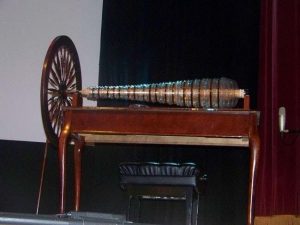
 good idea how to play the Glass Armonica. Debuted in 1761, it was beautifully engineered with blown glass bowls. To play it, you simply wet your fingers and touched the various bowls to get a variety of sounds. The instrument was so popular that Beethoven and Mozart began creating music for it. Unfortunately the novelty wore off after a time, and that is why most people don’t even know what it is today. Ben Franklin was a man of many talents, and yet all we ever really thought about was the discovery of electricity.
good idea how to play the Glass Armonica. Debuted in 1761, it was beautifully engineered with blown glass bowls. To play it, you simply wet your fingers and touched the various bowls to get a variety of sounds. The instrument was so popular that Beethoven and Mozart began creating music for it. Unfortunately the novelty wore off after a time, and that is why most people don’t even know what it is today. Ben Franklin was a man of many talents, and yet all we ever really thought about was the discovery of electricity.
 I don’t know of any family relationship that exists in my family or in Bob’s family, but I have always had an interest in Benjamin Franklin anyway. I have done a lot of hiking in my life, and sometimes, like it or not, bad weather comes in before we were done with our hike. I think anyone who has hiked much knows that one of your worst enemies on a hike…other than mountain lions, bears, or snakes…is lightning. Personally, when I start to hear thunder, I figure it’s time to head for shelter, but when you are four or five miles from your car, in the middle of a bunch of trees, heading for shelter isn’t always an easy task.
I don’t know of any family relationship that exists in my family or in Bob’s family, but I have always had an interest in Benjamin Franklin anyway. I have done a lot of hiking in my life, and sometimes, like it or not, bad weather comes in before we were done with our hike. I think anyone who has hiked much knows that one of your worst enemies on a hike…other than mountain lions, bears, or snakes…is lightning. Personally, when I start to hear thunder, I figure it’s time to head for shelter, but when you are four or five miles from your car, in the middle of a bunch of trees, heading for shelter isn’t always an easy task.
Ben Franklin, on the other hand saw lightning as a challenge to be explored. I think he had to have known the dangers of such an adventure, because he was a scientist after all. That didn’t really matter to him much, or if it did, he did not show it. Ben Franklin became interested in electricity in the mid-1740s. Not much was known about the subject, but he would spend the next decade conducting experiments using electricity. It was Ben who coined terms still in use today. You now them…battery, conductor, and electrician. He also invented the lightning rod, which is now used to protect buildings and ships. All of these things came from his many experiments. Ben Franklin was an amazing man, publisher, and writer, but it is really not in his writings that I find myself intrigued, but rather his electrical experiments. On this day, June 10, 1752, Ben flew his now infamous kite during a thunderstorm to collect a charge in a Leyden jar, when the kite was struck by lightning. He wanted to demonstrate the electrical nature of lightning.
Benjamin Franklin was born January 17, 1706. People might think that Benjamin Franklin was a highly educated man, but in reality, his formal education ended at age ten. Then he went to work for his brother, James as a printer, but after a dispute in 1723, he left Boston and moved to Philadelphia and found work as a printer. He moved to London for a short time and worked there as a printer, and then returned to Philadelphia. He became a successful businessman whose publishing ventures included the Pennsylvania Gazette and Poor Richard’s Almanack, a collection of homespun proverbs advocating hard work and honesty in order to get 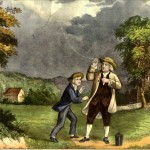 ahead. Eventually, Benjamin Franklin became an overachiever…or at least in the eyes of many people. I think he was just interested in a lot of things.
ahead. Eventually, Benjamin Franklin became an overachiever…or at least in the eyes of many people. I think he was just interested in a lot of things.
Of course, we all know about Benjamin Franklin’s career as a statesman, which spanned for decades, his years as a legislator, and his diplomatic years in England and France. He is the only politician to have signed all four documents fundamental to the creation of the US: the Declaration of Independence (1776), the Treaty of Alliance with France (1778), the Treaty of Paris (1783), which established peace with Great Britain, and the U.S. Constitution (1787). Yes, he was an all around amazing man, but I will always love the idea of his lightning experiments the best.

